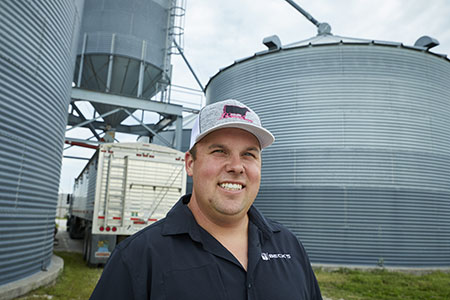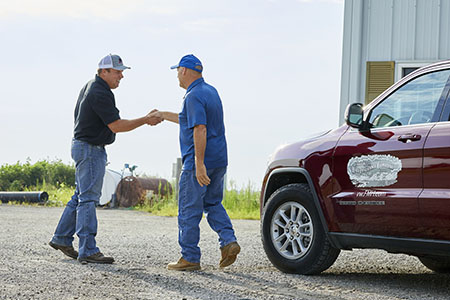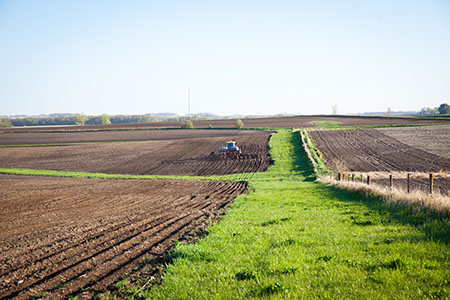Enhanced Coverage Option, or ECO, is the new federal product making headlines this spring. With coverage up to 95 percent of expected crop value, it’s no wonder this insurance endorsement is catching the attention of so many.
To learn why farmers should consider adding ECO to their risk management plans this year, we spoke with two ECO experts from Farmers Mutual Hail: Ryan Benes, FMH Strategic Account Manager, and Ken Ripley, FMH Regional Sales Manager and Assistant Vice President of Sales.
1. ECO doesn’t have the same restrictions as SCO.
While ECO has been called a sister product to SCO, or Supplemental Coverage Option, there are differences that make it accessible for more farmers.
 “If you know what SCO is, you’re already halfway there,” said Benes. “Just like SCO, ECO is going to follow the underlying plan type: it uses the same prices, it has the same sales closing date, and ECO is an area-based plan of insurance. What makes it enhanced? ECO offers 95 or 90 percent coverage down to 86 percent.”
“If you know what SCO is, you’re already halfway there,” said Benes. “Just like SCO, ECO is going to follow the underlying plan type: it uses the same prices, it has the same sales closing date, and ECO is an area-based plan of insurance. What makes it enhanced? ECO offers 95 or 90 percent coverage down to 86 percent.”
SCO’s highest trigger level caps out at 86 percent.
Ripley added, “Unlike SCO, where that could only be purchased if you signed up for Price Loss Coverage (PLC) at the Farm Services Agency (FSA) office, ECO can be purchased regardless of what you sign up for. That’s a big win and simplifies it.”
2021 is an election year for producers to choose either PLC or Agriculture Risk Coverage (ARC) at their FSA office. Producers can add both SCO and ECO to their crop insurance plans but should talk to their FMH agent about the best options for their risk management needs.
2. ECO is an endorsement on top of existing coverage – yes, you can even have a “gap.”
ECO can be added to either revenue or yield individual plan types, and to any underlying coverage level.
“There’s no level requirements with ECO, meaning you don’t need to have a certain level of coverage on your underlying buy-up plan in order to purchase ECO at 95 percent level,” explained Benes.
“In the past, some of the push back with similar products were if you had a 75 percent policy, you were forced to buy up to 85 percent [to qualify for those higher coverage levels]. Now we can have that gap,” said Ripley. “That’s a big win – having the opportunity to put a higher trigger in but keep the individual level low.”
Ripley added that allowing the gap in coverage makes adding ECO’s higher level coverage more affordable.
3. Do your farm's yields usually trend in the same pattern as county yields?
As an area-based plan, ECO pays when the county experiences a loss, not the individual farm.
 “When you think about an area plan, you have to start thinking about your county. All losses are going to be based on how that county performs versus the individual producer’s actual loss or production,” said Ripley. “With ECO, you could get hit and the county wouldn’t get hit, and you’re not going to be covered.”
“When you think about an area plan, you have to start thinking about your county. All losses are going to be based on how that county performs versus the individual producer’s actual loss or production,” said Ripley. “With ECO, you could get hit and the county wouldn’t get hit, and you’re not going to be covered.”
He went on to explain how the Risk Management Agency (RMA) sets an Expected County Yield in the spring for each county, “which is like the county’s APH.” That number will be used along with the Actual County Yield to determine if a loss is triggered for ECO.
“Because it’s an area-based plan, we always have to look at what the Actual County Yield was instead of your individual production coming in. So, to come up with an area yield, we have to get production from all the producers in the county. That takes time – in a lot of areas, the last date to report production is in the month of April. So, after that gets in and processed, we’re looking at a June payment with this product,” explained Ripley.
While a later claim payment and spot loss exposure concerns might deter some producers from ECO, Ripley said to do your own research with your FMH agent to determine if it’s right for you.
“I would encourage the grower to truly look at their risk needs on their farm. If their risk needs are tied to spot losses like wind or hail events, they definitely want to stay with private products. Look at your risk portfolio and buy the product that best fits your needs,” he said.
4. The data doesn’t lie: ECO pays.
ECO offers 95 or 90 percent coverage down to 86 percent, a range that is considered shallow because the county’s actual yield or price only needs to drop a few points to trigger a loss, and thus a payment.
 “We’re going to get some payments with this,” said Benes. “It has a very shallow loss trigger level of 95 percent. So, when we look at the Expected County Yield and if we’re going to come in lower than 5 percent of the yield, then we’re going to trigger a payment. If we look at revenue, and we fall more than five percent from an average year, then we’re going to trigger a payment.”
“We’re going to get some payments with this,” said Benes. “It has a very shallow loss trigger level of 95 percent. So, when we look at the Expected County Yield and if we’re going to come in lower than 5 percent of the yield, then we’re going to trigger a payment. If we look at revenue, and we fall more than five percent from an average year, then we’re going to trigger a payment.”
Benes calculated just how often this shallow loss trigger might occur with some real county historical data.
“I picked a county up in Ken’s neck of the woods and one near me: Blue Earth County, Minnesota, and Dallas County, Iowa. I looked back at the last 19 years’ worth of data to get an estimate of what kinds of payments we would have received over that time with ECO. For both Dallas County and Blue Earth County, ECO would have paid at the 95 percent level in nine of those 19 years for corn. That’s just under 50 percent! We are going to trigger payments fairly often with ECO because it is such a high level of coverage.”
5. ECO is available almost everywhere and covers 31 different crops.
Traditionally, area-based plans have not been popular in the western half of the U.S. Benes explained why that is, and why producers in those states shouldn’t overlook ECO just yet.
“We see a lot more area-based plans sold east of the Mississippi in general and there’s a couple of good reasons for that,” he said. “One is we just don’t get as much hail and not as much wind. Essentially, not as many of those spot losses. For producers west of the Mississippi, those are real risks they face.
“Another reason is just pure geography. If you look at the size of a county, say, in Indiana compared to the size of a county in South Dakota, those size of counties are quite a bit different. If I farm in a county that is geographically smaller, I am more likely to trend with that county yield versus if I am in a much larger county.”
So, what makes ECO different? Benes points to how the product can work with individual-based plans:
 “With ECO, that [area-based] trend doesn’t necessarily have to hold true. The main reason being that I, as a producer, still get to keep my individual underlying coverage. I don’t have to give that up at all. This is just a chance for me to buy extra coverage to capture those shallow yield losses – those shallow revenue losses in particular – where I might not have been able to be even close to capturing those small losses.”
“With ECO, that [area-based] trend doesn’t necessarily have to hold true. The main reason being that I, as a producer, still get to keep my individual underlying coverage. I don’t have to give that up at all. This is just a chance for me to buy extra coverage to capture those shallow yield losses – those shallow revenue losses in particular – where I might not have been able to be even close to capturing those small losses.”
6. ECO is actually pretty affordable.
ECO has a lot of factors working in the grower’s favor in terms of cost: area-based plans are usually less expensive than individual plans, the gap in coverage means growers don’t need to “buy-up” to that higher coverage level, and it’s a subsidized product as part of the federal program. Plus, ECO has a Percent of Price Option that can lower the premium cost but still allow that higher coverage band.
“The Percent of Price Option allows you to buy anywhere from 100 percent of the price down to 50 percent of price in one percent increments, so you can mix and match,” explained Ripley.
“Historically, your goal is to keep your loss trigger as high as possible. Instead of looking at the 90 percent level – even though that’s going to be a lower cost – you can put a 95 percent level in at 50 percent price and you’re going to the be at the cost of a 90 percent level at 100 percent price. So, it gives you that higher trigger and keeps your cost at a similar standpoint,” he added.
The Percent of Price Option is independent from the underlying policy, so it only affects the ECO cost and coverage.
 Talk to Your FMH Agent About ECO
Talk to Your FMH Agent About ECO
Benes and Ripley said the best thing interested growers can do is talk to their FMH agent, who can help them review their own county’s historical data, assess their operation’s individual risk needs, and provide them with a quote on ECO coverage.
Learn more or find an agent: www.fmh.com/lead/eco


